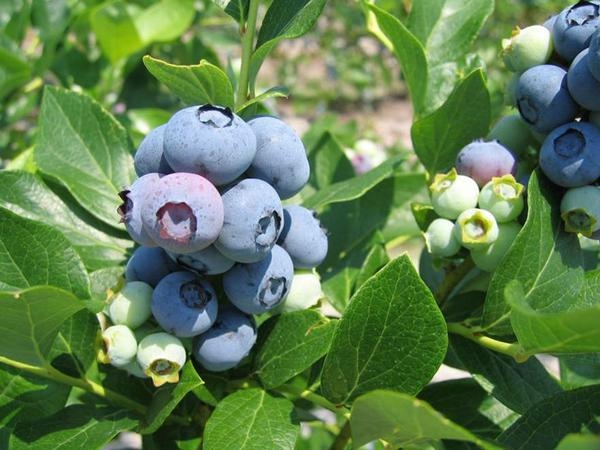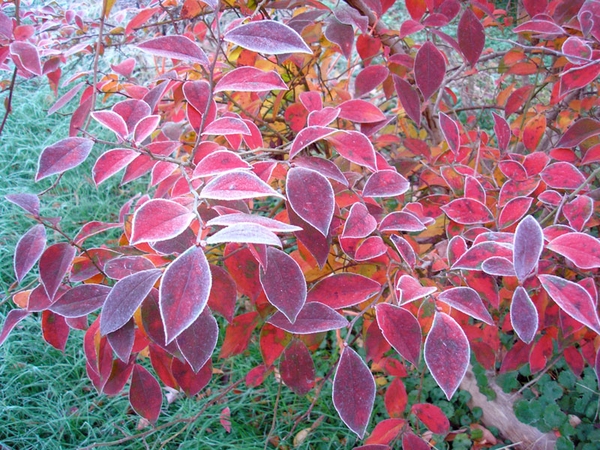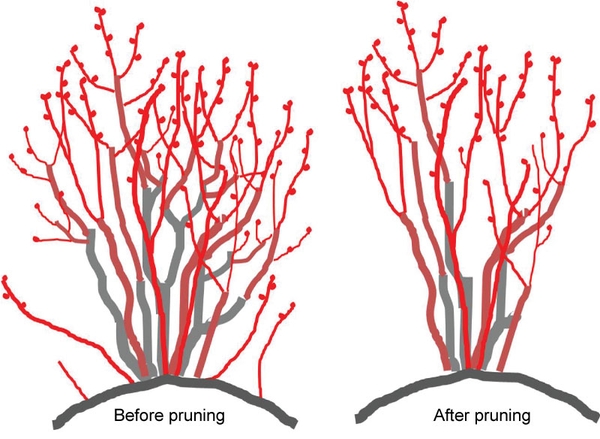In addition to their delicious fruit, blueberries also provide year-round interest in the garden. Bell-shaped white flowers are popular with native bees in the spring, the fruit is beautiful and nutritious in the summer, and the fall leaves are gorgeous. Best of all, blueberries are relatively easy to grow.
Choose Where to Plant
Blueberries need full sun and enough space for each of them to grow 4 to 6 feet wide. For more information on planting, see the Blueberry section of the "Small Fruits" chapter in the North Carolina Extension Gardener Handbook.
Select Blueberries That Will Thrive in Your Location
Rabbiteye blueberries grow well across the state of North Carolina; some favorite cultivars are listed below. You must plant at least two different cultivars that bloom at the same time to cross-pollinate the flowers. Don’t plant just one bush that fruits in the early season and one that fruits in the late season as the bloom periods may not overlap enough to provide cross-pollination. If you have space, choose cultivars from each season to prolong your harvest.
- Early Season: ‘Robeson’, ‘Climax’, ‘Premier’
- Mid-Season: ‘Columbus’, ‘Ira’
- Late Season: ‘Tifblue’, ‘Powderblue’, ‘Onslow’
Get Them Off to a Good Start
Late winter is the best time to plant, but you can plant at other times as long as you keep the plant watered. Dig a hole as deep as the root ball and twice as wide. Place the plant in the hole and refill it with the soil you dug out. Do not add compost or other amendments to the soil used to fill in the hole. Water the area well. Add a 3-to-4-inch-deep layer of organic matter (pine bark, pine needles, wood chips, or sawdust) in a doughnut shape beginning 4 inches from the trunk and spreading out between 36 and 48 inches. After planting, remove all but the strongest three or four shoots and remove all flower buds. Do not fertilize immediately after planting. Blueberries can also be grown in large containers.
For more information on selecting blueberries for your locations, see the blueberry section of the "Small Fruits" chapter in the North Carolina Extension Gardener Handbook.
Taking Care of the Plant
Water
Blueberry plants require 1 to 2 inches of water every week of the growing season, either from rain or irrigation.
Fertilizer
Follow the directions on the fertilizer bag carefully as blueberry plants are easily damaged by excess fertilizer.
- First year: After the first leaves appear in the spring, apply 1 tablespoon of 10-10-10 fertilizer in a circle 1 foot from the plants. Repeat at approximately six-week intervals before rainfall or irrigation until mid-summer.
- Second year: Apply 2 tablespoons in a circle around the plants 1½ feet from the trunk.
- Third and each following year: When new growth begins in spring, apply 1 cup of a complete fertilizer such as 10-10-10 in a circle 3 feet from the plant.
Mulch
Reapply mulch 2 inches deep each year as the existing mulch breaks down.
Prune
Each year in late winter, remove dead, diseased, weak, crossing, low-angled, and insect-infested wood. Remove the oldest, lichen-covered, gray stems. Keep only three or four large upright stems. Make between one and three large cuts to open the center of the bush if it is overcrowded. Cut back any overly vigorous shoots.
Remove all but a few flower buds in the late winter of the second year. Do not remove flower buds after the second year as bushes can produce a full crop in year three.
Harvest
Blueberry fruit ripens approximately two months after blooming, although harvest time varies with cultivar, weather conditions, and plant vigor. Plants produce an average of ½ pound per bush in the third year, and 1 to 2 pounds per bush beginning in the fourth year. Pick all ripe fruit on the bush at each visit to avoid insect and bird problems. Do not handle fruit when it is wet. Refrigerate berries to extend their shelf life. Bag and discard all damaged fruit. Do not compost damaged fruit as insect pests can survive.
For more information on growing blueberries, see the Blueberry section of the "Small Fruits" chapter in the North Carolina Extension Gardener Handbook.
Troubleshooting Common Problems
Hand-pull weeds. Avoid using a hoe around blueberries as they are shallow-rooted and easily damaged.
See Table C-3: Problems Common to Blueberries in the North Carolina Extension Gardener Handbook, for information about managing common problems with blueberries.
Fun with Blueberries
Books
- Wild Berries by Julie Flett
- Blueberries for Sal by Robert McCloskey
Videos
- "More Blueberries | Read Aloud Books." Marissa Rivera Read Aloud Books. November 16, 2020. Video.
Activities
- Growing Minds: recipes and virtual tours of blueberry farms
Additional Resources:
- NC State Extension Horticulture
- Garden Help Directory — Contact the local N.C. Cooperative Extension center in your county.
Acknowledgments
Funding for this publication was provided in part by the John Rex Endowment.
The authors would like to thank Melissa Bell, Research Associate, Center for Environmental Farming Systems Field Research, Education and Outreach Liaison, NC State University, for their management of the review process.
This publication was developed in partnership with the Natural Learning Initiative in the College of Design at North Carolina State University.
About the Local Foods Series: Childcare Center Production Gardens
This publication in the Local Foods series is one of 15 publications about childcare center production gardens:
- Growing and Cooking Fruits and Vegetables at Childcare Centers (LF-007-01)
- Creating Childcare Center Production Gardens (LF-007-02)
- Growing Warm-Season Fruits and Vegetables in Childcare Production Gardens (LF-007-03)
- Growing Cool-Season Vegetables in Childcare Production Gardens (LF-007-04)
- Snacking and Cooking with Warm-Season Produce from Childcare Production Gardens (LF-007-05)
- Snacking and Cooking with Cool-Season Produce from Childcare Production Gardens (LF-007-06)
- Composting in Childcare Center Production Gardens (LF-007-07)
- Vermicomposting in the Childcare Center Production Gardens (LF-007-08)
- Introducing Children to Insects in Childcare Center Gardens (LF-007-09)
- Easy Fruits to Grow at Childcare Center Gardens (LF-007-10)
- Growing Strawberries in Childcare Center Gardens (LF-007-11)
- Managing Weeds in Childcare Center Gardens (LF-007-12)
- Growing Fruit Trees in Childcare Center Gardens (LF-007-13)
- Growing Muscadines in Childcare Center Gardens (LF-007-14)
- Growing Blueberries in Childcare Center Gardens (LF-007-15)
Publication date: July 27, 2023
LF-007-15
N.C. Cooperative Extension prohibits discrimination and harassment regardless of age, color, disability, family and marital status, gender identity, national origin, political beliefs, race, religion, sex (including pregnancy), sexual orientation and veteran status.





